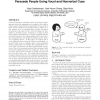30 search results - page 3 / 6 » Designing a socially assistive robot for pediatric care |
HRI
2012
ACM
12 years 3 months ago
2012
ACM
Social robots have to potential to serve as personal, organizational, and public assistants as, for instance, diet coaches, teacher’s aides, and emergency respondents. The succe...
ICRA
2000
IEEE
13 years 11 months ago
2000
IEEE
We describe the design and testing of a robotic system to assist locomotion training of spinal-injured rodents. The goal of the system is to control and quantify spatialtemporal p...
HRI
2009
ACM
14 years 2 months ago
2009
ACM
The concept of the huggable robot Probo is a result of the desire to improve the living conditions of children in hospital environment. These children need distraction and lots of...
ICRA
2007
IEEE
14 years 1 months ago
2007
IEEE
–This paper presents a novel affect-sensitive human-robot interaction framework for rehabilitation of children with autism spectrum disorder (ASD). The overall aim is to enable t...
IROS
2007
IEEE
14 years 1 months ago
2007
IEEE
— This paper describes a novel Home Lift, Position, and Rehabilitation (HLPR) Chair, designed at National Institute of Standards and Technology (NIST), to provide independent pat...


